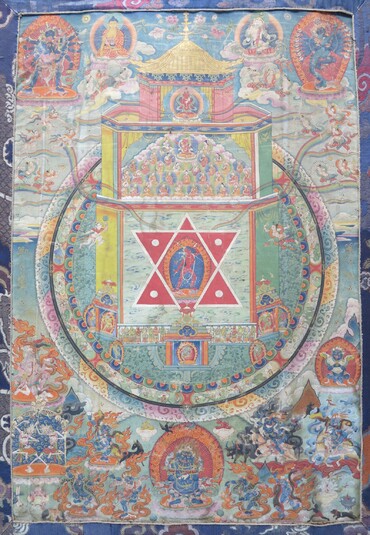
Item: Vajrayogini (Buddhist Deity) - (Naropa Tradition)
| Origin Location | Tibet |
|---|---|
| Date Range | 1700 - 1799 |
| Lineages | Sakya, Ngor (Sakya) and Buddhist |
| Material | Ground Mineral Pigment on Cotton |
| Collection | Private |
Classification: Deity
Appearance: Semi-Peaceful
Gender: Female
Vajrayogini and the Pure Land of Khechara (Tibetan: dor je nal jor ma, kha cho), from the tradition of mahasiddha Naropa. Vajrayogini is meditational deity and has as her special function or activity the goal of reaching complete enlightenment in a single lifetime. She belongs to the Chakrasamvara cycle of Tantra literature.
Sanskrit: Vajrayogini Tibetan: Dor je nal jor ma
Tibetan: Dor je nal jor ma
At the center of the mandala in the middle of two triangular shapes is the dakini Vajrayogini, of the Naro Khechari lineage, with one face and two hands surrounded by a ring of orange flame. She is standing on a double tetrahedron (two triangles) within a three-storied heavenly palace. Resting on a large double vajra within a circular mandala dwelling within the larger buddha realm of Akanishta, this is the pure buddha-realm of Vajrayogini. Offering goddesses and several animal-headed protector deities are seen below as door guardians. On the upper floor of the palace are the lineage of Sakya teachers descending from the Indian teacher Naropa. On the top story of the palace is Buddha Vajradharma, red, holding a vajra and bell at the heart.
At the top left side is a golden Shakyamuni Buddha and the meditational deity Chakrasamvara. On the right side is a white Vajrasattva and the meditational deity Hevajra.
In the lower half of the composition below the central mandala are the principal protectors of the Sakya School. At the bottom center is Panjarnata Mahakala with one face and two hands. To the right and left are five wrathful attendants, all blue in colour and surrounded by orange flames. They are called the Five Activity Servants. At the far left are Brahmarupa Mahakala and the two dancing skeletons Shri Shmashana Adhipati. On the far right side is Ekajati holding a vase with both hands at the level of the heart. Below that are two forms of Shri Devi (Tib.: pal den lha mo). Dudsolma has four hands and rides a brown donkey and Magzor Gyalmo has two hands and rides atop a mule.
Vajrayogini is a representation of complete buddhahood in female form. Classified as Wisdom or 'Mother' Supreme Yoga Tantra the practices originate with the Chakrasamvara Cycle of Tantras. Although found in a variety of forms the basic practice of Vajrayogini is common to all schools of Tibetan Buddhism. In this form she represents a special teaching passed down from the lineage of the Indian mahasiddha Naropa through to the Sakya School and later found popularity within the Gelug Tradition of Tibetan Buddhism.
Guru Lineage: Vajradhara, Vajrayogini, mahasiddha Naropa, Phamthingpa, Sherab Tseg, Mal Lotsawa, Sachen Kunga Nyingpo, Sonam Tsemo, Trakpa Gyaltsen, Sakya Pandita, Chogyal Pagpa, etc.
The unique elements and characteristics of this painting are first the unusual composition with the mixing of a standard figurative painting with the more technical composition of a mandala. The painting is also trying to show perspective, lending a feeling of three dimensionality. The crossed triangles in the center are understood to be two tetrahedrons merged into one shape with the points facing down and the flat surfaces at the top and the three sides.
Jeff Watt 12-2015
Buddha Form | Female Form | Wrathful Form
Exhibition: Female Form (DM)
Buddhist Deity: Vajrayogini Main Page
Buddhist Deity: Vajrayogini, Khechara Pureland
Buddhist Deity: Vajrayogini, Khechara (Naropa Tradition)
Collection of Dhargye Museum
Collection of Dhargye Museum (Painting Gallery 1)

